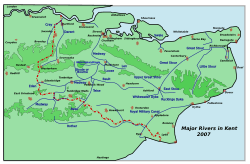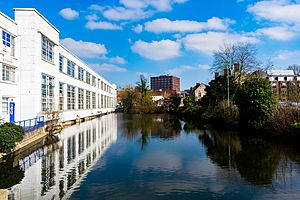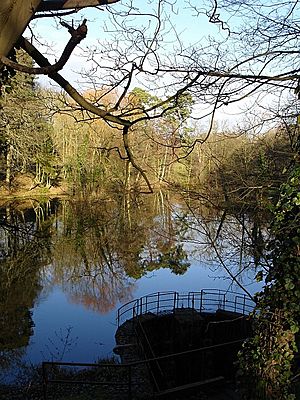River Len facts for kids
Quick facts for kids Len |
|
|---|---|

Kent rivers, showing the Len.
|
|
| Country | England |
| Region | Kent |
| District | Maidstone |
| Physical characteristics | |
| Main source | Bluebell Woods near Platt's Heath in Kent Maidstone, England |
| River mouth | joins River Medway |
| Length | 16 km (9.9 mi) |
| Basin features | |
| Tributaries |
|
The River Len is a river located in Kent, England. It starts from a spring in Bluebell Woods, southeast of Lenham village. This is very close to where the River Great Stour also begins. Both rivers start on the Greensand Ridge, a line of hills. The River Len is about 16 km (9.9 mi) long and flows into the River Medway in Maidstone.
The river generally flows towards the west. For much of its early journey, it runs next to the M20 motorway. It flows between Fairbourne Heath and Harrietsham, then past Broomfield. After Broomfield, the river forms the beautiful lake next to Leeds Castle. The Len then enters the town of Maidstone, south of Bearsted, and becomes the lake in Mote Park. Finally, it joins the River Medway about 1.25 miles (2.01 km) further on.
Historically, the River Len and its smaller streams were very important. They powered many watermills in areas like Ulcombe, Leeds, Hollingbourne, Boxley, and Maidstone. These mills helped local communities by grinding grain or processing materials.
Contents
- Watermills of the River Len
- Polhill (Holme) Mill, Harrietsham
- Chegworth Mill, Ulcombe
- The Mille, Broomfield
- Le Mille, Broomfield
- Leeds Castle Mill, Broomfield
- Keepers Cottage Mill, Broomfield
- Old (Boxley, Hollingbourne, Hurst, Mote Hole) Mill, Leeds
- Brandescombe (Buscombe, Fulling) Mill, Leeds
- Thurnham (Ballard's) Mill
- Thurnham Mill
- Otham Mill
- Otham Paper Mill
- Poll (Pole, Mote) Mill, Boxley
- Turkey Mill, Boxley
- Christian's Mill, Maidstone
- Padsole (Lenworth) Mill, Maidstone
- Church Mill, Maidstone
- Little Church Mill, Maidstone
- Tributaries
- Watermills on the Tributaries
Watermills of the River Len
The River Len was a source of power for many watermills along its path. Here are some of them, listed from the river's source to its mouth:
Polhill (Holme) Mill, Harrietsham
This mill has a long history, dating back to the Domesday Book. It was first recorded as Holemiln in 1254. For a while, it was a fulling mill, which means it was used to clean and thicken wool fabric. Later, it became a corn mill, used for grinding grain into flour. The mill collapsed and was demolished in 1929, but some parts of its machinery still exist.
Chegworth Mill, Ulcombe
Chegworth Mill was first mentioned in 1317. It was known as the Lower Mill at one point and later as Pendmill. This mill was a corn mill and continued to work until the late 1960s. It had a large waterwheel that was about 10 feet 10 inches (3.30 m) in diameter. This wheel powered three pairs of millstones, which ground the grain. The mill building was converted into a house around 1990.
The Mille, Broomfield
This mill might also be a Domesday site, meaning it was recorded in the Domesday Book of 1086. It was shown on a map from 1649. The mill used a waterwheel that was likely a breastshot or overshot type, meaning the water hit the wheel either in the middle or from the top.
Le Mille, Broomfield
This mill was first mentioned in 1368 as a fulling mill. It was also marked on a map of Leeds Castle in 1649. It seems to have stopped working sometime after the 1660s.
Leeds Castle Mill, Broomfield
A mill was recorded at Broomfield in the Domesday Book, even before Leeds Castle was built. It started as a corn mill but might have been changed into a fulling mill by 1368. The mill building that still stands today is from the early 1200s. It stopped being used in the mid-1600s. The waterwheel for this mill was powered by the lake at Leeds Castle.
Keepers Cottage Mill, Broomfield
This is a possible site for an old mill. A building was marked on a 1748 map of Leeds Castle on an island near Keeper's Cottage. If a mill was here, it likely disappeared by the end of the Middle Ages.
Old (Boxley, Hollingbourne, Hurst, Mote Hole) Mill, Leeds
This mill was located on the border between Hollingbourne and Leeds. In 1654, it was a fulling mill. By 1733, it had been converted into a papermill by James Whatman, a famous papermaker. It was later changed back to a corn mill by 1852. In 1908, it was even used to grind cocoa beans! The mill was very tall, with five storeys, and had a large overshot waterwheel. Most of its machinery was removed during World War II, and the mill was demolished around 1955.
Brandescombe (Buscombe, Fulling) Mill, Leeds
This mill was given to the Priory of Leeds by Robert de Crevecoeur the Younger. It was a corn mill at first, but by 1628, it had become a fulling mill. The mill stopped being used sometime before 1843. The building that remains today dates back to the 1400s.
Thurnham (Ballard's) Mill
This was another Domesday mill. In 1635, it was described as two corn mills and a fulling mill. The fulling part was later stopped. This mill was demolished around 1828, and a new mill was built further downstream.
Thurnham Mill
This mill was built in the late 1820s. It had a large overshot waterwheel, about 9 feet (2.74 m) in diameter, which powered four pairs of millstones for grinding grain. The Blinkhorn family were millers here for a long time. The mill worked until World War II, when its waterwheel axle broke. Most of the machinery was then removed. In 1986, the mill was sold and converted into a house.
Otham Mill
Also known as Bearsted Mill, this corn mill was built in 1837. It was still standing in 1939.
Otham Paper Mill
Otham Paper Mill was originally built as a fulling mill in 1527. It had two overshot waterwheels. By 1700, it had been changed into a papermill. In the 1830s, a paper-making machine was installed, but it was later moved, and the mill was used to clean and prepare rags for paper making.
Poll (Pole, Mote) Mill, Boxley
This mill started as a fulling mill and was later converted to a papermill. It was bought by James Whatman Jr in 1785 and worked together with Turkey Mill. Sadly, this mill was demolished in 1836 to create the large lake at Mote Park in Maidstone.
Turkey Mill, Boxley
TQ 772 556 51°16′19″N 0°32′29″E / 51.271883°N 0.541323°E Turkey Mill was first a fulling mill between 1640 and 1671. It was later converted into a papermill. This mill became very famous because James Whatman and his son developed 'wove' paper here. This special paper was smoother and had no lines from the manufacturing process. Turkey Mill grew to be the largest paper mill in the country.
The mill was sold in 1792 for a huge sum of £32,000. It continued to produce paper for over 280 years, which is the longest continuous paper production by any mill in Great Britain! It finally closed in 1976.
Watermarks Paper from Turkey Mill often had special watermarks. The famous 'J Whatman' watermark was used for paper made there. Later, paper was marked 'Original Turkey Mill', 'O.T.M.', or 'T & J Hollingworth'.
Uses of Paper from Turkey Mill The paper made at Turkey Mill was very high quality and used by many famous people:
- The artist Thomas Gainsborough used it for his drawings.
- J. M. W. Turner, another famous artist, also used Whatman paper.
- William Blake used it for four of his illustrated books.
- Even Napoleon wrote his will on Whatman paper!
- Queen Victoria used it for her personal letters.
- It was also used in the House of Commons library.
- In the 1930s, Soviet leaders used Whatman paper to publish their first five-year plan.
- At the end of World War II, the peace treaty with Japan was written on Whatman paper.
Christian's Mill, Maidstone
This was a fulling mill. It was demolished by 1735 and replaced by houses.
Padsole (Lenworth) Mill, Maidstone
This mill might also be a Domesday site. It was involved in a dispute in 1313-14. In 1449, it was a fulling mill. By 1548, it was a large complex with two wheat mills, two fulling mills, a malt-mill, and two potchers (machines for preparing paper pulp). The mill was rebuilt as a papermill in 1795. It was later demolished in 1874, and a new corn mill was built nearby. The last mill building survived until the 1980s.
Church Mill, Maidstone
Church Mill might be one of the five Domesday mills recorded in Maidstone. It was standing in 1572. In 1752, it had two pairs of French Burr millstones and one pair of Peak millstones for grinding grain. The mill was demolished in 1903 to make way for a road widening project, but its millpond still exists today.
Little Church Mill, Maidstone
This mill was located on a bypass watercourse from Church Mill. In 1752, it had one pair of French Burr millstones and four bolting mills (for sifting flour). It was demolished in the early 19th century.
Tributaries
The River Len has several smaller streams, called tributaries, that flow into it. Many of these streams also powered watermills.
- Two streams start at Harrietsham and each powered a watermill before joining the River Len.
- The Hollingbourne Stream begins at the foot of the North Downs and powered four watermills before meeting the River Len. It's also known as the Snagbrook or Snakebrook.
- A stream starts north of Bearsted and powered two watermills before joining the River Len.
- A stream rises in Leeds and powered three watermills before flowing into the River Len.
Watermills on the Tributaries
Streams at Harrietsham
Selesbourne
This was a grinding mill, used for corn.
The Fair Bourne
The Fair Bourne stream starts in a quarry. It powered one watermill.
Fairbourne Mill, Harrietsham
This mill was likely a Domesday mill. In 1768, it was described as "two water corn mills under one roof." It was rebuilt in 1796. This corn mill had an overshot waterwheel that drove two pairs of millstones. Milling at Fairbourne stopped in 1908. The mill building still stands, but its machinery is gone.
Hollingbourne Stream or Snagbrook
This stream powered four mills.
Manor Mill
A mill might have been on this site since 980. The mill and house were rebuilt in 1880. The main axle of its watermill broke in 1925, ending its working life. The mill building still exists with its waterwheel, but no other machinery.
Eyhorne Mill
This corn mill was working in 1839. It stopped working sometime between 1885 and 1898. The waterwheel was likely breastshot, meaning water hit it in the middle.
Grove (Cotteram's, Old) Mill
This mill was probably a corn mill at first, then a fulling mill, and later a papermill during the 1700s and 1800s. It was working until at least 1885, and the building was later demolished.
Park (New) Mill
This mill was also likely a corn mill, then a fulling mill, and later a papermill. In 1847, it was producing pasteboard. A paper-making machine from this mill was sold in 1892. The mill was later demolished.
Leeds Stream
Le Nethertoune Mill, Leeds
This was a fulling mill that was recorded as being "in ruins" in 1466.
Abbey Mill, Leeds
This was probably a Domesday mill. It was one of five mills owned by the people of Leeds. It had a large cast iron overshot waterwheel that powered three pairs of millstones. The mill was in ruins but mostly intact in 1936, but parts were later demolished. Some machinery still remains inside.
Priory (North) Mill, Leeds
This mill was first recorded in 1608. By 1834, only a few parts of its walls remained.
Stream at Bearsted
This stream powered two mills.
Aldington Mill, Thurnham
Aldington Mill was a Domesday mill, meaning it was recorded in the Domesday Book of 1086.
Lower Milgate Mill, Bearsted
This mill was part of a small estate and appeared on maps from the early 1700s.





